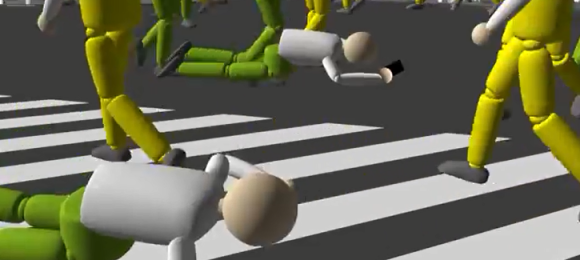
In recent years, Shibuya’s scramble intersection has shot to international fame as a symbol of the sheer energy and extreme congestion that can be found in downtown Tokyo. The five-road nexus is one of the busiest crossings in the world, and it’s not unusual to see as many as 1,500 people making their way across it – usually in opposite directions – when traffic in all directions stops.
With such a massive amount of pedestrians trying to get to the other side, navigating the scramble intersection without careening into anyone can be a tricky affair, especially with three giant video screens and several times as many mini-skirted legs pulling your attention away. But what if we added yet another distraction, in the form of every single person staring at their smartphone as they crossed? How many collisions would we see then? 10? 20? 50?
Try hundreds.
NTT Docomo, Japan’s largest cell phone provider, has become concerned about the growing number of smartphone related accidents in Japan. Of course, you can’t have smartphone accidents unless you have smartphones first, so Docomo can’t help feeling a little culpable.
Of course, using the same unfair logic of elementary school teachers, it takes two to have a collision, one to collide and one to be collided into. So even if a few people can’t tear their eyes away from their personal best round of Candy Crush or the stellar piece of Internet journalism they’re perusing on their phone, as long as everyone else keeps an eye out, things should be OK, right?
Docomo decided to take this attitude to its mathematical extreme, though. What if everyone crossing the Shibuya scramble was staring at their phone? To investigate just how much bedlam this would cause, the company ran a simulation, then recreated the results in the following computer animated video.
First, let’s take a closer look at the five streets that come together to form the intersection.
It’s worth remembering that both blocks in the bottom half of the diagram function as exits for the incredibly busy Shibuya Station, and that the third street from the right (the one without a crosswalk stretching across it) is the pedestrian thoroughfare called Center Gai. The street’s collection of shops, fast food joints, and bars means that Center Gai is packed at pretty much all hours of the day, which means a steady people gushing out of and hurtling into the point where it meets up with the scramble intersection.
For its simulation models, Docomo used the average size of a Japanese adult, with a height of 160.3 centimeters (5 feet, 3.1 inches) and weight of 58.8 kilograms (129.4 pounds).
Since Shibuya sees both people leisurely window shopping and hurrying to catch a train, the simulation uses three different walking speeds, ranging from 3 to 6 kilometers an hour (1.9-3.7 miles per hour).
Each model’s field of vision was adjusted to reflect staring at a smartphone, with the unit held below eye level, for a total range of perception that Docomo calculates is just five percent of what your eyes can take in normally. The resulting loss in awareness means that a person looking at their screen won’t see another pedestrian until the two are within one and a half meters (4 feet, 11 inches) of each other.
Once the two notice each other, Docomo’s simulation accounted for three possible reactions each person could take, stopping, moving forward while dodging to the side, or continuing straight ahead.
With the parameters all set and the recreated intersection stocked with 1,500 models, it was time for Docomo to turn its digital marionettes loose.
Linguistically ironic as it may be, predictably, chaos ensued.
In the event two pedestrians couldn’t avoid each other, the test factored in three potential outcomes, with one being to stop and apologize in the Japanese way, with a deep, respectful bow.
Unfortunately, stopping to bow means spending more time in the middle of the intersection itself, where you’re still an obstacle for other people to bump into, often setting off a chain reaction of bowing.
To represent stronger jolts, some models, upon being hit, drop their phones and stop to stare in shock.
Most dramatically of all, some pedestrians collide with such force that they’re completely laid out in the middle of the street.
So, what’s the total damage, for a single green light?
446 collisions
103 knockdowns
21 dropped smartphones
Most pitiful of all, though, is that after taking out all the models which collided or had to apologize to someone, only 547 out of the 1,500, or a paltry 36 percent, made it to the other side of the street without incident.
So remember, everyone, save your mobile phone for when you’re not mobile, and keep your eyes front when you’re out and about. And for those of you who absolutely have to be playing with your phone at all times, we recommend a tactile diversion, rather than a visual one, as you cross the Shibuya scramble.
Source: Hachima Kiko
Video, images: YouTube

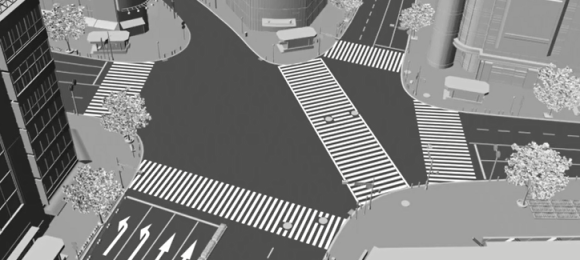
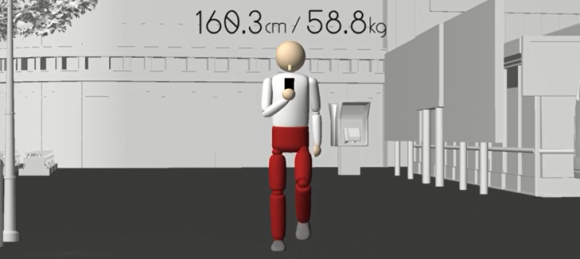

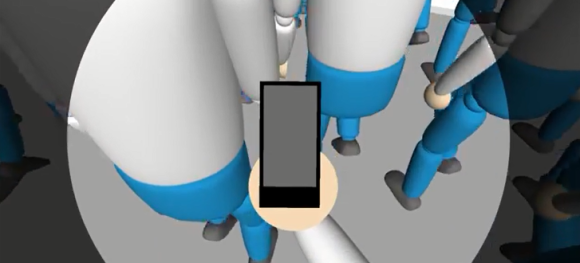
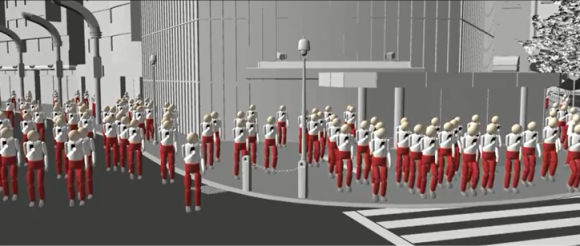
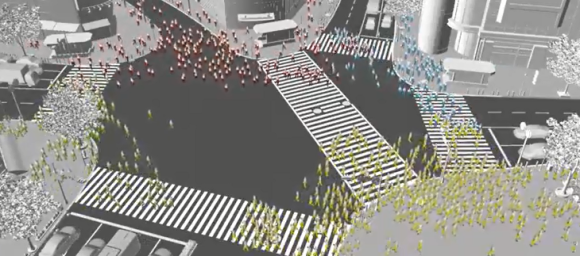
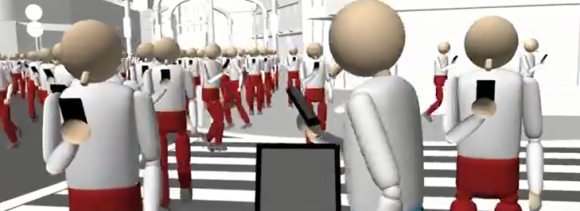
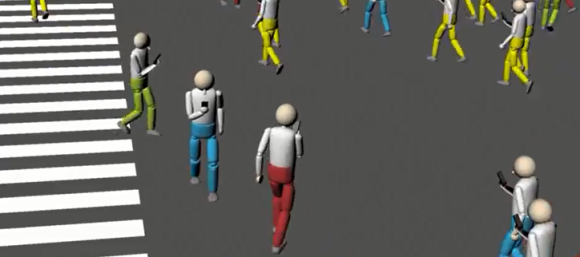
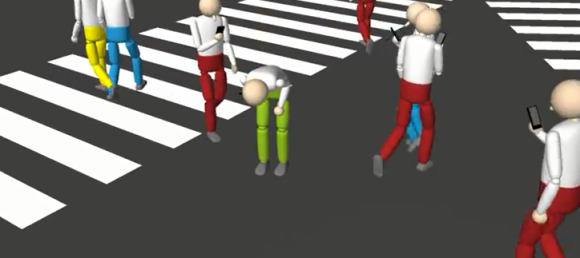
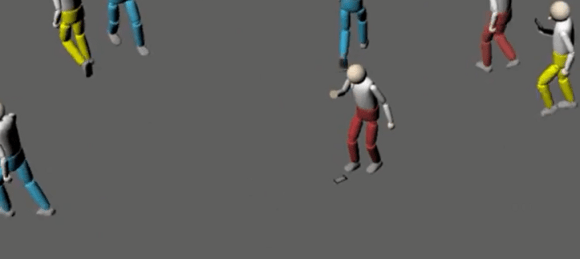
 Hamee (Strap-ya) to release charming catbutt cradles for your phone
Hamee (Strap-ya) to release charming catbutt cradles for your phone Man crosses Shibuya scramble crossing in inflatable ball
Man crosses Shibuya scramble crossing in inflatable ball Japanese YouTuber sleeps on a bed in the middle of Shibuya Scramble Crossing【Video】
Japanese YouTuber sleeps on a bed in the middle of Shibuya Scramble Crossing【Video】 Man attempts to set himself on fire in middle of Tokyo’s busiest intersection【Video】
Man attempts to set himself on fire in middle of Tokyo’s busiest intersection【Video】 Tokyo’s biggest street party spot bans public drinking on New Year’s Eve
Tokyo’s biggest street party spot bans public drinking on New Year’s Eve Kyoto Whopper divides customers at Burger King Japan
Kyoto Whopper divides customers at Burger King Japan Taking the Kyoto overnight bus for the first time
Taking the Kyoto overnight bus for the first time Starbucks Japan unveils second Holiday Frappuccino for 2024
Starbucks Japan unveils second Holiday Frappuccino for 2024 Japan’s caramel gacha machines offer sweet thrills, but do they deliver?
Japan’s caramel gacha machines offer sweet thrills, but do they deliver? Japanese burger chain no longer serves onion rings, but offers intriguing replacement【Taste test】
Japanese burger chain no longer serves onion rings, but offers intriguing replacement【Taste test】 Forbidden area at Japanese mountaintop shrine opens to the public for first time in 400 years
Forbidden area at Japanese mountaintop shrine opens to the public for first time in 400 years Hello Kitty isn’t a cat!? We called Sanrio to find out!
Hello Kitty isn’t a cat!? We called Sanrio to find out! Ghibli’s Princess Mononoke teams up with Foxfire for outdoor apparel collaboration【Photos】
Ghibli’s Princess Mononoke teams up with Foxfire for outdoor apparel collaboration【Photos】 New card game makes Japan’s saunas even steamier
New card game makes Japan’s saunas even steamier How to properly pronounce “Ghibli” and other fun trivia about the legendary animation studio
How to properly pronounce “Ghibli” and other fun trivia about the legendary animation studio One of Japan’s most beautiful hot spring towns announces new limits on number of day trippers
One of Japan’s most beautiful hot spring towns announces new limits on number of day trippers Berserk T-shirts coming to Uniqlo for launch of new Manga Curation line【Photos】
Berserk T-shirts coming to Uniqlo for launch of new Manga Curation line【Photos】 Mario Kart Happy Meal toys arrive at McDonald’s Japan, and SoraNews24 has the whole set!【Photos】
Mario Kart Happy Meal toys arrive at McDonald’s Japan, and SoraNews24 has the whole set!【Photos】 After cancelling Halloween, Tokyo’s Shibuya neighborhood cancels New Year’s Eve too
After cancelling Halloween, Tokyo’s Shibuya neighborhood cancels New Year’s Eve too Tokyo park’s sea of clouds, nighttime illumination, and cosplay days make now perfect time to visit
Tokyo park’s sea of clouds, nighttime illumination, and cosplay days make now perfect time to visit Samurai ritual suicide contest cancelled by organizer in west Japan
Samurai ritual suicide contest cancelled by organizer in west Japan Japanese job-quitting service contacted by other job-quitting service because employee wants to quit
Japanese job-quitting service contacted by other job-quitting service because employee wants to quit Flying dango: Unique tourist site where Japanese sweets are flown to you over a gorge
Flying dango: Unique tourist site where Japanese sweets are flown to you over a gorge American jackass tourist arrested after carving name into gate at Tokyo’s Meiji Shrine【Video】
American jackass tourist arrested after carving name into gate at Tokyo’s Meiji Shrine【Video】 Nintendo’s controller capsule toys are so cool, even the machine you buy them from is awesome【Pics】
Nintendo’s controller capsule toys are so cool, even the machine you buy them from is awesome【Pics】 Tokyo Disneyland loses top-attendance crown for Japanese theme parks for second year in a row
Tokyo Disneyland loses top-attendance crown for Japanese theme parks for second year in a row Ghibli Park debuts first winter illumination display with Howl’s Moving Castle theme
Ghibli Park debuts first winter illumination display with Howl’s Moving Castle theme Pringles releases a limited-edition sweet flavour in Japan
Pringles releases a limited-edition sweet flavour in Japan Sanrio and magical girl anime PreCure join forces for new merch line【Photos】
Sanrio and magical girl anime PreCure join forces for new merch line【Photos】 What’s the deal with akebi, the perfectly purple, alien-like fruit that’s in season now in Japan?
What’s the deal with akebi, the perfectly purple, alien-like fruit that’s in season now in Japan? McDonald’s new Happy Meals offer up cute and practical Sanrio lifestyle goods
McDonald’s new Happy Meals offer up cute and practical Sanrio lifestyle goods Foreign tourists on Shinkansen bullet train break suitcase etiquette, angering local passengers
Foreign tourists on Shinkansen bullet train break suitcase etiquette, angering local passengers [Deleted] Article written for April Fool’s Day 2018
[Deleted] Article written for April Fool’s Day 2018 Japanese government to make first change to romanization spelling rules since the 1950s
Japanese government to make first change to romanization spelling rules since the 1950s Foreigner’s request for help in Tokyo makes us sad for the state of society
Foreigner’s request for help in Tokyo makes us sad for the state of society Ghibli founders Toshio Suzuki and Hayao Miyazaki contribute to Japanese whisky Totoro label design
Ghibli founders Toshio Suzuki and Hayao Miyazaki contribute to Japanese whisky Totoro label design Japanese convenience store Family Mart announces abolishment of eat-in spaces
Japanese convenience store Family Mart announces abolishment of eat-in spaces Princesses, fruits, and blacksmiths: Study reveals the 30 most unusual family names in Japan
Princesses, fruits, and blacksmiths: Study reveals the 30 most unusual family names in Japan Life-size vibrating Legend of Zelda Master Sword for sale from Nintendo【Photos】
Life-size vibrating Legend of Zelda Master Sword for sale from Nintendo【Photos】 Studio Ghibli releases free-download board game — Here’s how to play it without reading Japanese
Studio Ghibli releases free-download board game — Here’s how to play it without reading Japanese World-famous Shibuya scramble crossing to become even more epic with giant(er) screens
World-famous Shibuya scramble crossing to become even more epic with giant(er) screens Frightening video shows car speeding through Tokyo’s Scramble Intersection filled with people
Frightening video shows car speeding through Tokyo’s Scramble Intersection filled with people SoraNews24 hits Tokyo’s biggest Halloween party dressed as one of Japan’s most popular characters
SoraNews24 hits Tokyo’s biggest Halloween party dressed as one of Japan’s most popular characters Tokyo’s most famous Starbucks is closed
Tokyo’s most famous Starbucks is closed Brand-new Tokyo Shibuya Scramble intersection opens…but over 50 miles away from Tokyo?!【Photos】
Brand-new Tokyo Shibuya Scramble intersection opens…but over 50 miles away from Tokyo?!【Photos】 Japanese custom of bowing to cars at crosswalks keeps locals safe, warms Internet’s hearts【Video】
Japanese custom of bowing to cars at crosswalks keeps locals safe, warms Internet’s hearts【Video】 University of Tokyo lecturer suggests giving cars big cartoon eyes will make them safer
University of Tokyo lecturer suggests giving cars big cartoon eyes will make them safer First-ever Bon-Odori dance festival to be held at Shibuya scramble crossing for Obon
First-ever Bon-Odori dance festival to be held at Shibuya scramble crossing for Obon Serious accidents from walking while using smartphone up over 50 percent in Tokyo
Serious accidents from walking while using smartphone up over 50 percent in Tokyo Harrowing video sees reckless drivers ignore pedestrian crossing in Japan【Video】
Harrowing video sees reckless drivers ignore pedestrian crossing in Japan【Video】 Tokyo’s Shibuya district bans public drinking on New Year’s Eve, cancels countdown celebration
Tokyo’s Shibuya district bans public drinking on New Year’s Eve, cancels countdown celebration Cyclist in Tokyo ordered to pay $459,000 after collision leaves 74-year-old woman dead
Cyclist in Tokyo ordered to pay $459,000 after collision leaves 74-year-old woman dead Man shoots fireworks through crowd at Shibuya Scramble Crossing 【Video】
Man shoots fireworks through crowd at Shibuya Scramble Crossing 【Video】 Mayor tells people not to come to Shibuya for Halloween
Mayor tells people not to come to Shibuya for Halloween Ninja will murder you if you use your smartphone while walking, Japanese safety video warns
Ninja will murder you if you use your smartphone while walking, Japanese safety video warns
Leave a Reply